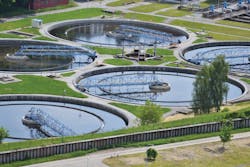Suction, discharge and reverse osmosis hoses for industrial water facilities
Many industries depend on water as a cleaning or cooling agent. However, those and other processes produce wastewater that contains impurities. Wastewater treatment allows the discharge of the water back into the ecosystem by removing impurities, solids and particulates.
In most instances, the wastewater treatment process begins with pumping — or lift — stations that pump the raw wastewater to treatment plants. Removing impurities from the water occurs in stages that remove coarse and fine debris, reduce solids content, eliminate organic materials and filter any pollutants from the water. Some wastewater treatments use carefully metered doses of chlorine or sodium hypochlorite to eliminate any microorganisms in the water and then add sulfur dioxide or sodium metabisulfite to neutralize the chlorine. Other applications use ultraviolet light — rather than chlorine — to remove any other microorganisms.
The pumps, hoses and pipes used in wastewater treatment facilities vary by industry and application. Water-intensive industries such as mining and steel mills use different processes to remove solids, oils, greases, toxic chemicals, organic chemicals and biodegradable organic materials from water. While wastewater treatment facilities for pulp and paper mills remove acids, phenols and chlorinated hydrocarbons, food processing operations generate wastewater that contains biodegradable, nontoxic particulate matter and surfactants.
Solids removal methods
Filtration
As an example of the different treatment methods and applications, some industrial wastewater facilities apply filtration to remove and recover solids. Membranes in ultrafiltration systems reduce the amount of oil in wastewater by approximately 98%. Using the same concept, reverse osmosis systems (RO) use semipermeable membranes to remove solids, salts and contaminants from water. Disposable paper bed filters remove solids from process liquids. Vacuum filtration systems draw contaminated coolant water through a vacuum chamber and a disposable filter.
API devices
Wastewater facilities for chemical plants, natural gas processing plants, petrochemical plants and other industries use combinations of American Petroleum Institute (API) water separators, parallel plate separators, sludge pumps, membrane filters, chain and flight scrapers, and skimming devices to recover oils, greases and hydrocarbons from water. Water separators use the specific gravity between suspended oil and water to separate oil and suspended solids from wastewater effluents. Skimmers remove oil and grease layers from water and rely on heaters to maintain the fluidity of high viscosity hydrocarbons.
Pumps
These and other types of wastewater treatment operations also use different types of pumps to transfer wastewater. End suction centrifugal pumps handle moderately aggressive liquids that contain suspended solids. Wastewater treatment facilities often use slurry pumps to transfer sediment solids. Positive displacement peristaltic pumps provide an efficient and reliable method for moving water that contains solids, particulates and fine matter. Progressive cavity pumps work well for moving thick, viscous and abrasive fluids. Submersible pumps completely submerge the pump and motor in high-temperature, high-pressure wastewater applications and push water in pump and lift stations.
Hose materials
Regardless of the type of wastewater treatment facility and the type of industry, the treatment processes may use suction, discharge and RO hoses. The food processing, chemical manufacturing, agricultural and construction industries use suction and discharge hoses to transport water. Boiler feedwater treatments use RO to trap bacteria, salts, organics, silica and hardness from the water. Because of the different requirements and the different types of pumps used for wastewater conveyance, the materials used to manufacture the hose must withstand positive and negative pressures, water, temperature variations, small particulates, oils and ultraviolet radiation.
As a result, manufacturers offer suction, discharge and RO hoses with tubes and covers made from polyvinyl chloride (PVC), ethylene propylene diene monomer (EPDM) and thermoplastic material. Two- and four-ply spiral wire reinforcement improves the hose’s resistance to vacuum, abrasion, impacts and weathering.
Polyvinyl chloride hose
Manufacturers produce PVC through addition polymerization process that forms PVC resin. The PVC production process begins with the extraction of salt and hydrocarbons to create chlorine that combines with ethylene to form the vinyl chloride monomer (VCM). Polymerization of the VCM causes the formation of a PVC resin. Blending the PVC polymer with other materials produces the properties that allow PVC hoses and pipes to work for a broad set of applications.
Those properties yield advantages such as high flexibility and durability. Lightweight PVC hose resists chemicals, corrosion, abrasion and wear. The smooth inner surface provides excellent flow characteristics for wastewater conveyance. PVC hose has low resistance to oils and extreme temperatures. Combining PVC with polyurethane (PVC/PU) increases the chemical and temperature resistance of the hose.
PVC suction, discharge and RO hoses resist abrasion and works in temperatures ranging from -10ºF to 150ºF. Depending on the application, PVC hose handles working pressures of 50 to 100 psi at mid-range temperatures. However, the pressure rating decreases to 35 to 65 psi at upper range temperatures. Corrugated PVC suction hose with a PVC helix reinforcement provides a small bend radius and maximum flexibility for tight turns while resisting crush forces. Soft wall PVC discharge hose provides the advantage of folding flat for storage and easy movement but work at lower working pressures ranging from 10 to 75 psi.
EPDM hose
EPDM rubber consists of synthetic rubber elastomer that provides strength and flexibility. The production of the elastomer occurs through the combination of ethylene and propylene copolymers and the chemical bonding of diene. Chemically tying the molecule chains of the elastomer together establishes the characteristics needed to obtain durability and resistance to cracking, peeling and breaking. In addition, EPDM remains flexible and reliable in temperatures ranging from -40ºF to 300ºF.
Wastewater suction and discharge hose manufacturers use EPDM for covers and tubes because of the advantages given by the material. While EPDM hose withstands abrasion and temperature extremes, it has a low resistance to oils.
An EPDM suction hose works at full vacuum and handles 75 to 125 psi. The agriculture, construction, mining and oil exploration industries use suction and discharge hoses with EPDM covers and tubes to convey water. Discharge hose made from two- and four-ply (EPDM) rubber and reinforced with high-strength polyester can handle pressures as high as 150 psi.
Thermoplastic hose
Thermoplastic copolymer-based elastomers combine the strength given through thermoplastics with the elasticity of thermoset rubber. The advantages of thermoplastic covers and tubes become apparent through enhanced thermal resistance. Thermoplastic hose retains fitting retention, flexibility and strength when exposed to temperatures ranging as high as 200ºC at high pressures. With its ability to withstand heat and pressure, thermoplastic hose also resists penetration by chemicals and oils. Manufacturers can use specific thermoplastic polymers to achieve different levels of pressure capabilities, resistance to chemicals and solvents and temperature operating ranges. The techniques used to bond thermoplastic covers, reinforcements and covers provide excellent adhesion between the hose layers.
Suction and discharge hoses manufactured with thermoplastic vinyl nitrile covers and tubes have working pressures ranging from 200 to 300 psi. When compared to other suction and discharge hose types, a thermoplastic hose offers greater kink and crush resistance but less chemical and heat resistance. The agriculture, construction, mining, paper and petroleum industries use thermoplastic hose to transfer water and slurries. The smooth internal surface of a thermoplastic tube resists erosion, maximizes flow efficiency and cuts any flow losses.
Avoid downtime with the right hose
Water treatment systems help industrial processes avoid downtime, expensive maintenance and equipment failure. In addition, those systems ensure that industrial operations comply with federal and state water regulations. Matching the selection of suction, discharge and RO hoses with wastewater treatment requirements for pressure, temperature resistance and chemical resistance allows the wastewater system to work efficiently.
It is important to note that most hose failures occur as the result of improper routing and abrasion against other hoses and structures. Getting proper length measurements or considering abrasion guards where it cannot be avoided is imperative.

